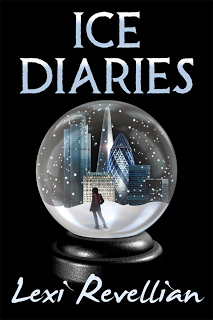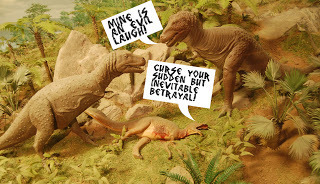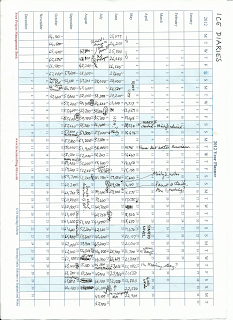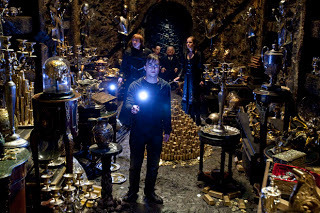Lexi Revellian's Blog, page 14
November 18, 2012
How to format ebooks for Kindle KF8
When I realized Ice Diaries' formatting was not changing size/fonts correctly on the Paperwhite Kindle, I did some research and reformatted using Kia Zi Shiru's method you can find here. It worked for me. I'm writing my own version hoping it may help other indie writers. Be warned, this is an exacting fiddly process that took me eight hours the first time. If you want to see what the end product looks like by this method, download Ice Diaries ' sample, or better still buy it :o)
IMPORTANT NOTE: to demonstrate without fusing Blogger, I have changed pointy brackets for square, i. e. < for [, and > for ].Make a new copy of your book in Word and call it 'TITLE for formatting'. Make sure the chapter headings are consistent, and the text is single-spaced. Using the pilcrow (the backwards P sign) to find them, remove any extraneous spaces at the ends of paragraphs. Do a Search and Replace replacing two spaces with one. Mark each pagebreak PB. Mark each word in italics with # - locate them by clicking Ctrl i in Find. Do the same for bold and underlined if you use them in the text. Don't mark titles, just the text.Download Libre Office and Notepad++ - they are free.Copy your Word document into Notepad++ in order to strip the formatting.Copy the text from Notepad++, open a new document in Libre Office and paste it in. Libre Office is good because unlike Word, it produces nice clean HTML. Close the Notepad++ file without saving, as you have finished with it now.Change the character set that LibreOffice uses for HTML, under Tools, Options, Load/Save, HTML compatibility. In the lower right there is Character set with a drop down menu next to it. Change this to Western Europe (ASCII/US).Go to File, Save As and save as TITLE html, as an HTML Document (Writer) (.html) from the drop down menu. When asked if you are sure, you are.At this stage, your whole text should show as Default in the top left box. If it doesn't, Select All and change it to Default.Go through the text making changes. Select the chapter headings and change them to Heading 1 in the box in the top left corner which otherwise says Default. I use H1 for the title on the title page, too. Don't bother centring at this point.Select each chapter title, if you have them, and change them to Heading 2.I change my name on the title page and Contents to bold at this stage.Search for #, hit delete to remove #, and put in italics as indicated. (If like me you use a lot of italics, you may find yourself losing the will to live.)Table of Contents: Amazon requires this at the front of the book. Highlight the heading Chapter 1 at the start of your first chapter, go to Insert and click on Bookmark. Type in Chapter 1 and OK. Do this for all your chapter headings.Go to your Table of Contents list. Click on Chapter 1. Go to Insert, Hyperlink. In the pop-up screen click on Document. Click on the circle with a dot on the second row, which opens a new pop-up. Click the + sign next to Bookmarks, and select Chapter 1. Click Apply, then Apply in the other window. Do this for all your chapters.To add links to your website or other books, highlight, click Insert, Hyperlink, and click on Internet. Paste the URL of the site you want the link to go to, and click Apply.Click File, Preview in Web Browser to check your links work. Don't worry that it looks kind of plain.Open Notepad++, click File, Open and open your Libre document, 'TITLE for formatting'.Add your title in line 5, between the tags. Delete lines 7 and 8.Look at the first of your [P] tags (Paragraph tags, these are your normal text). Anything between the [P and the last ] can be cut; copy it and go to Search and Replace. Paste the tag in the top line, [P] in the bottom, and Replace all. Do the same for [H1] and [H2] tags, but leave the [A] tags well alone, as they are your link tags.Go to everything coloured green between [STYLE] and [/STYLE], delete what is there and paste the following - but remember to change the square brackets in the code to < and >:
[STYLE]
p { text-indent:1.2em;} { margin-top:0em; margin-bottom:0em; }
.center { text-indent:0em; text-align:center; }
.noindent {text-indent:0em;}* {margin: 0;padding: 0;}[/STYLE]Now to add the page breaks. Do Search and Replace, replacing [P]PB[/P] with [mbp:pagebreak/]Centre lines you want centred: to do this, add class="center" between the first tag. So [P] becomes [P class="center"] (note there's a space after P) and [H1] becomes [H1 class="center"]. Do them all at once with Replace all. Woohoo!If, like me, you like the first line of a chapter or scene with no indent, then you need to change [P] to [P class="noindent"] where you want no indent. You will have to do each individually, I'm afraid.Save, and open Kindle Previewer which you can download free here. Open your book and check it. Looks good? Then email the file to your own Kindle for a final read-through and check. If you find any problems, go back to the Notepad++ version and tweak.You're done. Have a stiff drink and pat yourself on the back.
Published on November 18, 2012 08:19
November 11, 2012
Clicking Publish on Ice Diaries
 I have now clicked Publish, and ICE DIARIES is available to buy (or indeed ignore, according to taste) on Amazon
UK
and
US
.
I have now clicked Publish, and ICE DIARIES is available to buy (or indeed ignore, according to taste) on Amazon
UK
and
US
.It's an extraordinary moment for any self-publisher. Traditional publishing is very different; your book won't be on sale until about two years after you write THE END. By that time you've probably written another couple of books and have almost forgotten the one you now have to promote.
For indies like me, it's all much more immediate, and the buck doesn't just stop here, it's in permanent residence. I really hope readers are going to enjoy the story of Tori and her life in a post-apocalyptic London. They'll let me know.
 Here's a virtual toast to
Ice Diaries
- and readers, without whom writers would be nowhere.
Here's a virtual toast to
Ice Diaries
- and readers, without whom writers would be nowhere.N.B. Look Inside the Book hasn't appeared yet on the UK page - but you can read the sample on the US page, or on my website. I've also got pictures relevant to the story here.
Published on November 11, 2012 06:26
November 7, 2012
Title, cover and blurb - your opinion?
I'm nearly ready to publish my latest novel, and I'm doing my usual dithering over the title. Ice Diaries and Snow Globe are the current contenders. So I thought I'd ask you, my trusty blog readers, for your opinion. While you are here, would you cast an eye over the cover - figure/no figure - and the blurb for Amazon too?

BLURB
It’s 2018 and Tory’s managing. Okay, so London is under twenty metres of snow, almost everybody has died in a pandemic or been airlifted south, and the only animals around are rats. Plus her boyfriend never returned from going to find his parents a year ago when the snow began. But she’s doing fine. Really.
Home is an apartment that’s luxurious, if short on amenities, in a block which used to be home to rich City bankers. A handful of fellow survivors are her friends, and together they forage for food and firewood, have parties once a month and even run a book club. It’s all very civilized. The problem is that long-term they have no future; eventually the food will run out. Tory needs to find a way to make the two-thousand-mile journey south to a warm climate and start again.
Enter Morgan, a disturbingly hot cage fighter from a tougher, meaner world where it’s a mistake to trust people. He’s on the run from Mike, leader of the gang he used to work with. And he has a snowmobile.
Published on November 07, 2012 03:42
November 1, 2012
No paid professional will care as much as you do
 I'm sure you all recognize the quote...Passive Guy posted recently from a US agent's blog a piece entitled
Why agents collect your money for you
.
I'm sure you all recognize the quote...Passive Guy posted recently from a US agent's blog a piece entitled
Why agents collect your money for you
. The agent, Janet Kobobel Grant, explained that having publishers send the entire amount to the agent, instead of her 15% commission to her and the author's share to the author, was really for the author's benefit. She could check the amount (she didn't explain why a statement wouldn't do just as well) thus saving the author "happily skipping off to the bank to deposit an incorrect check".
This picture of the naive little author squealing, "Ooh! Money!" and in her enthusiasm failing to notice it was the wrong amount is typical of the patronizing way writers are treated by the publishing industry. We are told there are all sorts of things we can't possibly do for ourselves, so we need to pay most of our earnings to others in order to get them done for us. Of course this learned helplessness is handy for getting rights-grab contracts signed - don't worry your pretty little head with the details, just sign on the dotted line.
When dealing with professionals, it's best to bear in mind that you care an awful lot more about your job than they do. Whether it's a plumber, a solicitor or a literary agent, to them you are just one customer among many.
I've learned not to let other people do my thinking for me. I still remember the time I paid a for an opinion from a QC on the advice of my solicitor. The combined hourly charge was mind-boggling. I mentioned a possible problem I'd noticed, and they shook their heads in unison while reassuring me. I turned out to be right, they were wrong; they moved on to the next client and I paid for their bad advice each month for the next nine years.
Look at the comments on Janet Kobobel Grant's page from grateful authors agreeing with her. Then check out the comments beneath Passive Guy's post. It's herbivores and carnivores.
Don't be a herbivore. They'll chew you up and spit you out.
Published on November 01, 2012 09:13
October 21, 2012
Excellent Editing Software
 Part of Ice Diaries on Pro Writing AidYesterday I reached the end of the WIP, Ice Diaries. This is not quite as good as it sounds, as the last couple of chapters are sketchy and need more work, after which it has to go out to beta readers and have further adjustments, but it's still a pleasing moment.
Part of Ice Diaries on Pro Writing AidYesterday I reached the end of the WIP, Ice Diaries. This is not quite as good as it sounds, as the last couple of chapters are sketchy and need more work, after which it has to go out to beta readers and have further adjustments, but it's still a pleasing moment. As well as improving the end and tweaking the whole novel, this is the stage when I put the text chapter by chapter through editing software. For me this is an essential process because of my word echo habit - I'm capable of repeating a word three times in a short blog comment. My awareness of the problem enables me to catch a lot of instances, but not all. I've used Autocrit for the past three years, but discovered my subscription lapsed in July, and it was $77 to renew. This struck me as too much - three years ago I paid $35. So I searched Google for an alternative, and found Pro Writing Aid .
And it's really good - I'm so enthusiastic about it I probably need to add that I am unaffiliated with PRW and if you click on the link I make no money. The design and layout are nice and clear, and the window you paste into is large. The software will check your prose for all sorts of things, most of which I won't be using, but Repeated Words and Phrases and Overused Words are invaluable to me. I especially love the way Repeated Words shows repeats in a range of pretty colours, so you can see the twins (or worse, triplets) at a glance.
Best of all, Pro Writing Aid is free. Woot!
Published on October 21, 2012 04:48
October 10, 2012
How many words a day do you write?
 There's a terrifying thread on Kindleboards on this topic calculated to make the average writer feel inadequate. Here are a few sample comments:
There's a terrifying thread on Kindleboards on this topic calculated to make the average writer feel inadequate. Here are a few sample comments:"In a half hour session I can do up to 3k but 2,200 is my preferred comfortable pace. If I'm on deadline I get 15 - 20k done in a day. But 10k is my usual daily output if I'm working on something. But I have days where I'm just lazy."
"I tend to write in short bits, most days, say 500-1000 words. But I am a burst writer. My last four novels have had the final 20-25k words all written in one day."
"Under deadline, it can peak at 1k per hour some hours. Without a deadline, 3-4k per day."
"I write generally 1000 to 1400 words per 45 minute writing session. I aim for at least 4k a day, but 7k is better. My best day ever was about 14,000 words."
I tell myself these writers belong to the majority who forge ahead with a first draft, not rereading or correcting till they get to the end, when they face an equally large task of editing from scratch. I hope so anyway, because my output is tiny compared to these.
With the WIP, Ice Diaries, I've kept track of my daily word total, and it averages just under 400 words a day. I was aiming for 500. But I edit and tweak a great deal as I go, so when I reach The End a book is polished enough to go straight out to the first beta reader. Writing at that rate it's possible to finish a novel in about six months. In theory.
I think there are some lucky prolific writers who are able to write multiple books a year that please their readers - Amanda Hocking is a current example - but they are quite rare. Most of us, if we are honest, take a lot longer to finish a book, and are well advised not to rush the process. But perhaps I'm just making excuses...
What do you think?
Published on October 10, 2012 11:13
September 28, 2012
The price of ebooks and JK Rowling
 JK Rowling's first non-Potter novel was published yesterday, and
The Casual Vacancy
now sits at the top of the ebook and hardback charts in the UK and the US. Amazon is obliged to charge the price set by the publisher for the ebook; in the UK, this is £11.99, and £9.00 including free delivery for the hardback. This means the hardback is 25% cheaper than the digital version, which cannot be lent or passed on or sold second hand (Amazon will buy the hardback from you once you have read it for £4.50). Although ebooks include VAT, Amazon charges the Luxembourg rate of 3%.
JK Rowling's first non-Potter novel was published yesterday, and
The Casual Vacancy
now sits at the top of the ebook and hardback charts in the UK and the US. Amazon is obliged to charge the price set by the publisher for the ebook; in the UK, this is £11.99, and £9.00 including free delivery for the hardback. This means the hardback is 25% cheaper than the digital version, which cannot be lent or passed on or sold second hand (Amazon will buy the hardback from you once you have read it for £4.50). Although ebooks include VAT, Amazon charges the Luxembourg rate of 3%.Unsurprisingly, some readers who prefer the convenience of reading on a Kindle are fed up about this. Go to the book's reviews and (at time of writing) half of them are one star, mostly because of the price. Almost none of the people posting reviews, favourable or not, have read the book.
My view is the price is extortionate; Hachette are milking JKR's fans in a shameless way just because they can. I am surprised JKR has let them do this. Though setting the price is the province of the publisher, I'd be astonished if a writer with her clout had no hand in deciding on it. There is nothing about JoRo to suggest she is not one shrewd cookie.
Joe Konrath says it will be good for indie authors when the US Department of Justice's ruling on the Price-Fix Six (the five publishers who colluded with Apple to keep ebook prices high) comes into effect, as readers will have cash to buy more books if they spend less on well-known authors. I hope he is right.
(Any of my readers read TCV yet? I wasn't enamoured of the sample or what I've read in the newspaper reviews; I prefer novels with some likeable characters.)
Published on September 28, 2012 05:48
September 19, 2012
Fanfiction and why I don't approve
 Fanfiction has been in the news lately. Can anyone not know that EL James wrote an erotic series based on Twilight characters Bella and Edward, called Master of the Universe? She then changed the characters' names and 11% of the text. Benefiting from her own fans as well as piggy-backing on Stephanie Meyer's, the book, now called Fifty Shades of Grey, was bought by everyone on this planet except me.
Fanfiction has been in the news lately. Can anyone not know that EL James wrote an erotic series based on Twilight characters Bella and Edward, called Master of the Universe? She then changed the characters' names and 11% of the text. Benefiting from her own fans as well as piggy-backing on Stephanie Meyer's, the book, now called Fifty Shades of Grey, was bought by everyone on this planet except me.I don't approve of fanfiction. An author writes the story she means to, no more and no less, and it's gross impertinence of her 'fans' to attempt to write what she chose not to. Real fans would have more respect. Had Jane Austen wanted there to be a sequel to Pride and Prejudice, she'd have written it herself. Had JK Rowling envisioned Draco Malfoy and Hermione overcome by mutual lust, she'd have mentioned it in one of Harry Potter's seven volumes.
It doesn't help that the standard of writing is generally poor.
My stance on this clarified for me this week, when I was tracking down the last Mary Renault novel I haven't read, Kind Are Her Answers. It's an early one, so not one of her best, but I still want to read it. And I came across links to Mary Renault fanfiction sites. There's no way I was going to visit them, but it seems most of the stories add in the homosexual sex that Mary Renault chose not to describe in detail. Her view on the matter was:
"I have sometimes been asked whether I would have written this book more explicitly in a more permissive decade. No; I have always been as explicit as I wanted to be, and have not been much more so in recent books. If characters have come to life, one should know how they will make love; if not it doesn't matter. Inch-by-inch physical descriptions are the ketchup of the literary cuisine, only required by the insipid dish or by the diner without a palate."
She also, like any sensible person, disliked being pigeon-holed, and having some of her novels on the Gay and Lesbian shelves in libraries like my local one would, I feel sure, have annoyed her.
Yes, I know Shakespeare based some of his plays on other people's plots, using the same names. That's no excuse for us lesser mortals. Some writers argue that copying another's work is acceptable as a means of learning to write, like using training wheels on a bike. But a bike doesn't have an opinion on the matter, whereas most authors do. I'd certainly hate my characters to figure in another person's writing, and behave in ways I know they wouldn't.
Published on September 19, 2012 13:17
September 11, 2012
Creating isn't normal reality...
When I was doing a post-graduate jewellery course at the Royal College of Art, we all cared too much. Most of us spent our time straining to produce the ultimate piece of jewellery; something so ground-breaking and fabulous no one had ever seen its like before. This had a curiously stultifying effect on the students. One girl only produced six pieces in the three-year course. To get a degree, a modest nine were required, so the technician made up three designs for her.
Later, when working as a self-employed jeweller, and turning out the equivalent of a degree show every three months, I realized we'd been on the wrong tack. What we should have been doing was creating a body of work; making lots of things, including mistakes, then at the end of each term assessing what worked and what didn't, and moving on from there.
If you look at all of a writer's books, or an exhibition of a designer's work, there will be some things you love, others you don't. Mary Renault has written books I will reread for the rest of my life, and others (some of her early work) I've read once. Lalique was a genius, but a few of his pieces do nothing for me at all. And this is fine; fine for them, and for the rest of us too. Few mistakes are fatal. Let's all take risks, get things wrong, and care less about it. We're more likely to get it right in the end.
I have Jerry Cleaver’s Rules of the Page copied to the notes of each book I write. Here they are:
Creating isn't normal reality. You will make a mess. You must write badly first. Mistakes lead to discovery. Letting yourself be bad is the best way to become good. Everything can be fixed. The less you care, the better you write. Everything that happens is OK. Progress is never even. It will get good again—always. Keep writing no matter how awful it feels.

Later, when working as a self-employed jeweller, and turning out the equivalent of a degree show every three months, I realized we'd been on the wrong tack. What we should have been doing was creating a body of work; making lots of things, including mistakes, then at the end of each term assessing what worked and what didn't, and moving on from there.
If you look at all of a writer's books, or an exhibition of a designer's work, there will be some things you love, others you don't. Mary Renault has written books I will reread for the rest of my life, and others (some of her early work) I've read once. Lalique was a genius, but a few of his pieces do nothing for me at all. And this is fine; fine for them, and for the rest of us too. Few mistakes are fatal. Let's all take risks, get things wrong, and care less about it. We're more likely to get it right in the end.
I have Jerry Cleaver’s Rules of the Page copied to the notes of each book I write. Here they are:
Creating isn't normal reality. You will make a mess. You must write badly first. Mistakes lead to discovery. Letting yourself be bad is the best way to become good. Everything can be fixed. The less you care, the better you write. Everything that happens is OK. Progress is never even. It will get good again—always. Keep writing no matter how awful it feels.
Published on September 11, 2012 06:25
August 31, 2012
Modern iconic architecture in the WIP

Most large scale modern architecture does not appeal to me; it's too big, too in-your-face and lacks manners towards neighbouring buildings. Often boringly simple, too; I'm prejudiced against the sort of building you can take in at one glance. Try doing that with St Paul's, or the Palace of Westminster; there's too much subtlety of form and wealth of decoration. But in Ice Diaries, the novel I'm currently two thirds through writing, London is covered in twenty metres of snow from which only the tallest buildings emerge, and they are almost exclusively new buildings.
Bézier : This is a luxury block of flats on Old Street roundabout where my heroine, Tory, lives. Her flat is at snow level on the tenth floor. It's a distinctive building shaped like two half barrels. The manager very kindly showed me round, which was useful.The Gherkin: I'm quite fond of the Gherkin. It's an interesting addition to London's skyline, though it's now disappearing behind the tedious rectangular blocks of more recent even taller buildings. It has an innovative double skin that makes it extremely energy-efficient. My cage fighter hero hides his snowmobile there.The Barbican: brutalist sixties concrete, for a while the tallest residential blocks in Europe, built on an area bombed to rubble by the Germans in WW2. An historical part of London where Pepys once bought a table, it's a great loss to the City. The Barbican's layout is so maze-like it's unwise to try to cut across it. Beth Two in Replica was chased through the Barbican by MI5. In Ice Diaries, Tory and Morgan go to a ceilidh there in Shakespeare Tower. Strata : also known locally as Isengard or the Razor, this is a 43 storey block of flats of supreme ugliness at the Elephant and Castle on the south side of the Thames. It won the Carbuncle Award 2010 for 'the ugliest building in the United Kingdom completed in the last twelve months'. It has three wind turbines on top. In my novel, this enables the commune living there to have electricity.I feel the novel really should include the Shard, for the sake of completeness. But, unless the end of my book surprises me, its only appearance will be on the cover. (I've just redone the cover, and am as pleased as Punch and Judy with it.)
Published on August 31, 2012 05:11



